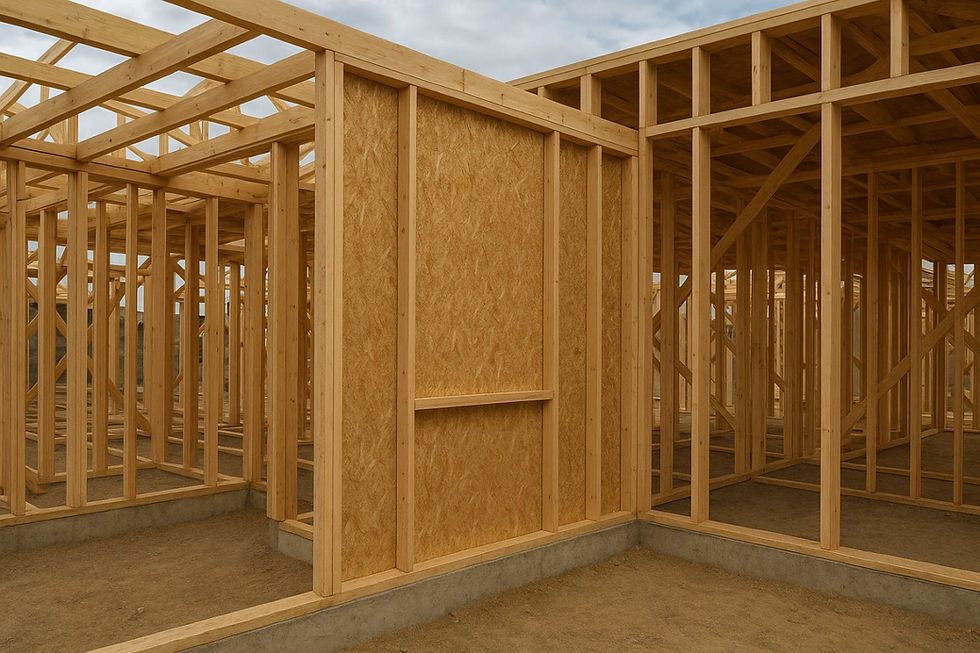Laterally Supported vs. Unsupported Foundation Walls in Ontario: Structural Design Guide
- Hoda Rajaeizadeh
- Sep 16
- 3 min read
Updated: 4 days ago
Foundation walls are critical structural elements in residential and commercial construction across Ontario. In addition to transferring vertical loads from the superstructure, they must safely resist lateral forces from soil, groundwater, and seismic effects.
The distinction between laterally supported and laterally unsupported foundation walls directly affects wall thickness, reinforcement requirements, and overall code compliance under the Ontario Building Code (OBC). Proper structural engineering design is essential to ensure stability, durability, and long-term performance.

Lateral Loads Acting on Foundation Walls
Foundation walls in Ontario are subjected to several lateral load sources that govern their design:
Soil Pressure: Active earth pressure varies with soil type, wall height, and embedment depth. Typical lateral pressures for 2–3 m of sandy soil range from 10–20 kPa.
Hydrostatic Pressure: When groundwater reaches the wall base, lateral pressure of approximately 10 kPa per metre of water height may develop.
Seismic Loads: Ontario has moderate seismicity, but seismic forces must still be considered where required by the OBC and NBCC.
Accurate load assessment ensures that foundation walls remain stable under all expected conditions.
Key Structural Design Considerations
Structural engineers must address the following when designing foundation walls:
Slenderness Ratio: Concrete foundation walls typically limit the height-to-thickness ratio to 25–30 to reduce buckling risk.
Vertical Reinforcement: Required at corners, ends, intersections, changes in wall height, openings, and movement joints.
Horizontal Reinforcement: Bond beams or ladder/truss-type reinforcement improve lateral capacity and crack control.
Openings: Large openings or total opening widths exceeding 25% of wall length significantly reduce capacity and require additional reinforcement.
Temporary Bracing: Essential for tall or unsupported walls before floor slabs or adjacent walls are constructed.
Common Foundation Wall Types in Ontario
Wall Type | Typical Use | Lateral Support Requirement | Key Structural Notes |
Solid Concrete / Unreinforced Block | Low-rise, low loads | Must be supported top or bottom | Thickness per OBC Table 9.15.4.2.A |
Residential basements | Supported top and bottom | Minimum 150 mm concrete core | |
Reinforced Concrete Block | Higher lateral loads | Often supported at top | Reinforcement per Table 9.15.4.2.B |
Selecting the appropriate wall system depends on height, soil conditions, insulation needs, and available lateral support.
When Is a Foundation Wall Laterally Supported at the Top?
Under OBC 9.15.4.3, a foundation wall is considered laterally supported at the top when:
It supports a solid masonry superstructure or an ICF wall above
Floor joists are embedded into or securely anchored to the wall
The floor system is bolted to the wall (joists may run parallel or perpendicular)
The wall extends no more than 300 mm above finished grade and is backfilled on both sides with a height difference not exceeding 150 mm
Proper anchorage is critical to ensure effective load transfer and prevent overturning.

Openings and Unsupported Wall Segments
Wall segments beneath openings are generally considered laterally unsupported unless reinforced. Key rules include:
Openings wider than 1.2 m require additional reinforcement
Combined opening widths greater than 25% of wall length must be treated as a single opening if spacing between them is limited
Reinforcement must extend from footing to wall top to maintain continuity
Practical Considerations for Ontario Projects
Assess site-specific soil and groundwater conditions early
Coordinate wall design with footing, slab, and floor systems
Use proper foundation wall insulation and moisture protection
Ensure temporary bracing is installed until permanent lateral support is in place
Verify compliance with OBC thickness, reinforcement, and support requirements
Conclusion
Designing laterally supported and unsupported foundation walls in Ontario requires careful application of structural engineering principles and strict adherence to OBC provisions. Soil pressure, hydrostatic forces, openings, and construction sequencing all influence wall performance.
At Parsways Inc., we provide structural engineering services for foundation wall design, including evaluation of lateral support conditions, reinforcement detailing, and OBC-compliant solutions for residential and commercial projects across Ontario.
Table 9.15.4.2.A and Table 9.15.4.2.B


Co-authored by Hoda Rajaeizadeh and Negin Amani.
FAQs
1) What makes a foundation wall laterally unsupported?
A wall is laterally unsupported when it lacks adequate restraint at the top or bottom to resist lateral soil and water pressures.
2) Do all foundation walls in Ontario require reinforcement?
Not always. Low walls with adequate lateral support may follow prescriptive OBC requirements, but taller or unsupported walls typically require reinforcement.
3) Why is temporary bracing important during construction?
Until floors or adjacent walls are in place, temporary bracing prevents instability and cracking in tall or unsupported foundation walls.


